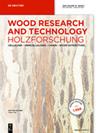热改性木材的冲击弯曲强度
IF 1.6
3区 农林科学
Q2 FORESTRY
引用次数: 0
摘要
摘要:本文提供了一个关于热改性如何影响五种不同木材的冲击弯曲强度的观点,这方面还没有像热改性木材(TMT)的静载荷行为那样得到那么多的关注。由于tmt主要用作户外材料,在那里它们可能会遇到冲击力,因此对这些材料在冲击下的柔韧性和强度进行比较研究是有用的。本文评估了TMT的不同方面,例如挠度,冲击区域的应变,启动裂缝所需的最大力以及破裂所需的能量。白蜡树、山毛榉、落叶松、橡树和云杉的木板在180和220°C下进行热改性。它们被切割成测试标本,而每一种木材的单独一组未修改的标本作为参照组。试件进行了冲击三点弯曲试验,超高速摄像机对试验结果进行了细致的记录。采用数字图像相关(DIC)方法对图像进行处理,确定梁在冲击试验过程中的挠度和应变分布。测定各组试件的挠度、最大受力、最大纵向应变和断裂所需功。结果表明,热改性可使木材挠度和最大纵向应变降低约50%。此外,冲击弯曲强度降低了近60%。然而,在180°C时,冲击弯曲强度没有统计学上的显著降低;在某些情况下,它甚至增加了。本文章由计算机程序翻译,如有差异,请以英文原文为准。
Impact bending strength of thermally-modified timber
Abstract The article offers a perspective on how thermal-modification affects the impact bending strength of five different wood species, an aspect that has not received as much attention as the well-studied static load behavior of thermally-modified timber (TMT). Since the TMTs are mainly employed as outdoor materials, where they may encounter impact forces, a comparative investigation into the flexibility and strength of these materials under impact is useful. This article evaluates different aspects of the TMT, such as deflection, strain in the impact region, the maximum force needed to initiate cracks, and the energy required for rupture. Wood planks from ash, beech, larch, oak, and spruce were thermally modified at 180 and 220 °C. They were cut into test specimens, while a separate set of unmodified specimens from each wood species served as the reference group. The specimens were subjected to an impact 3-point bending test, and an ultra-high-speed camera meticulously recorded the results. The images were processed by the digital image correlation (DIC) method to determine the deflection and strain distribution of the beams during the impact test. The deflection, maximum force, maximum longitudinal strain, and required work for rupture of each group were determined. The results showed that thermal-modification decreases the wood deflection and maximum longitudinal strain by approximately 50 %. In addition, the impact bending strength decreased by nearly 60 %. However, the impact bending strength did not exhibit a statistically significant decrease at 180 °C; in some cases, it even increased.
求助全文
通过发布文献求助,成功后即可免费获取论文全文。
去求助
来源期刊

Holzforschung
工程技术-材料科学:纸与木材
CiteScore
4.60
自引率
4.20%
发文量
83
审稿时长
3.3 months
期刊介绍:
Holzforschung is an international scholarly journal that publishes cutting-edge research on the biology, chemistry, physics and technology of wood and wood components. High quality papers about biotechnology and tree genetics are also welcome. Rated year after year as one of the top scientific journals in the category of Pulp and Paper (ISI Journal Citation Index), Holzforschung represents innovative, high quality basic and applied research. The German title reflects the journal''s origins in a long scientific tradition, but all articles are published in English to stimulate and promote cooperation between experts all over the world. Ahead-of-print publishing ensures fastest possible knowledge transfer.
 求助内容:
求助内容: 应助结果提醒方式:
应助结果提醒方式:


